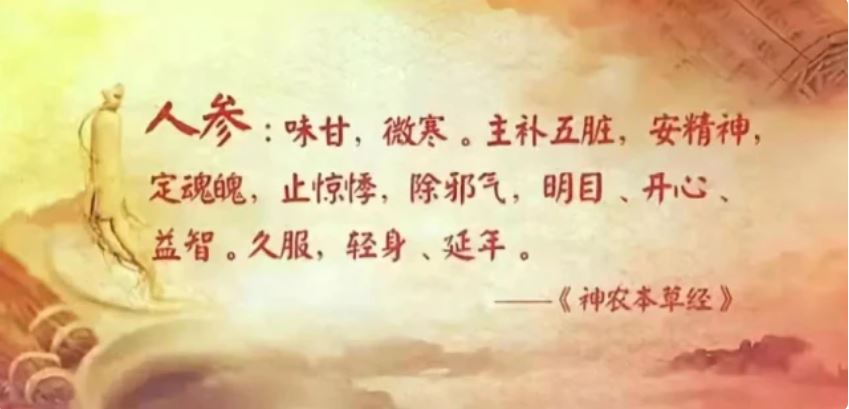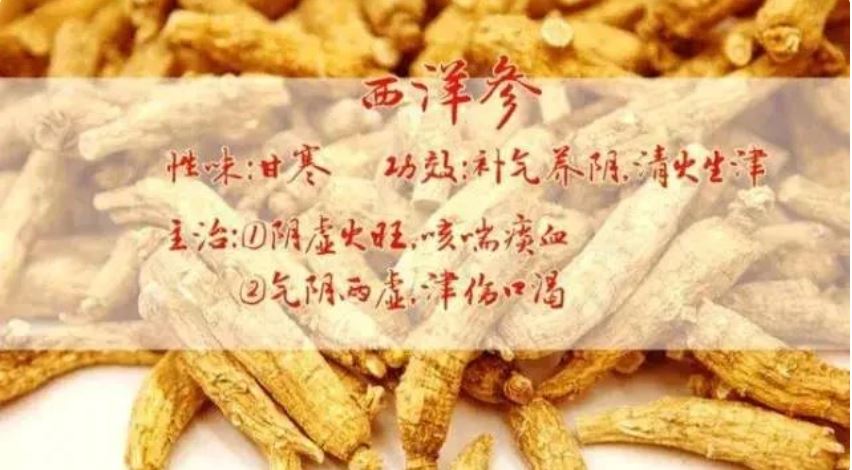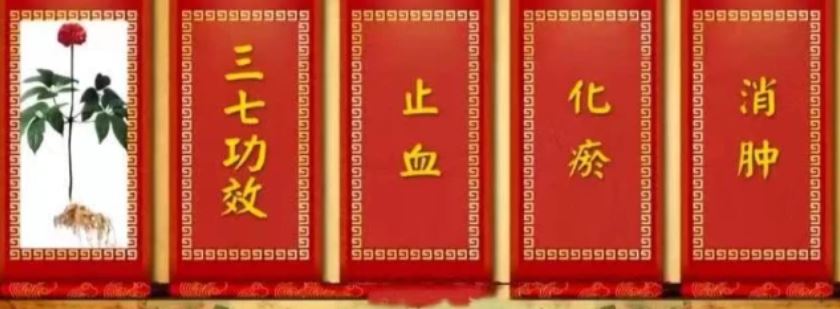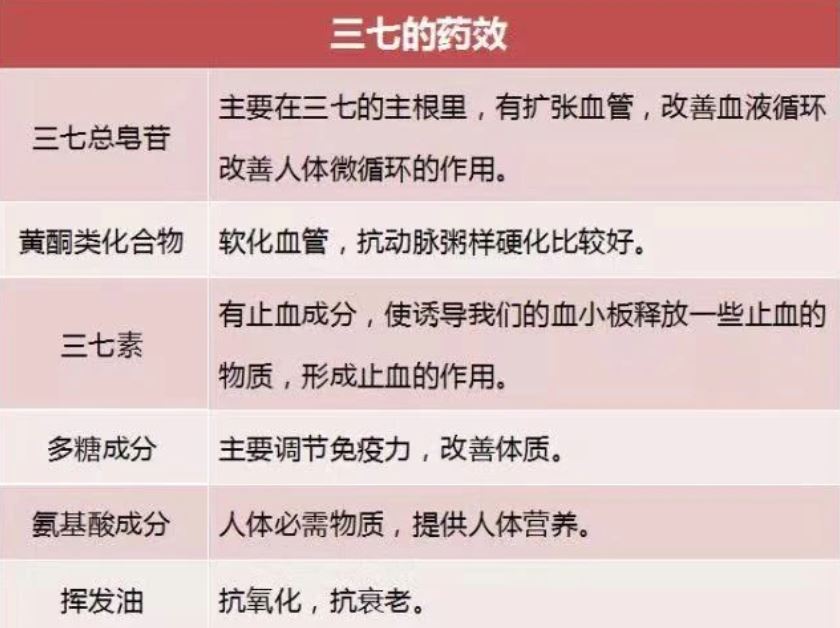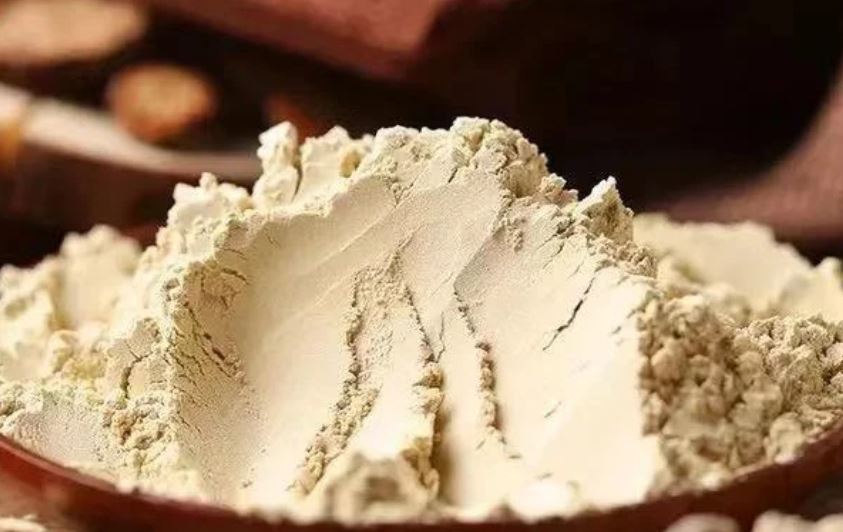According to TCM, a person is healthy when there is specific yin-yang and qi balance of the Functional Entities. Following info credit to amcollege.edu.
The functional entities are:
- The Five Fundamental Substances: Qi, Xue (Blood), Jinye (Body Fluids), Jing (Essence), and Shen (Spirit).
- Zang-fu: A Wu Xing cycle of 5 zang organs, 6 fu organs, and their functions
- Jing-luo: The channels or meridians through which qi flows
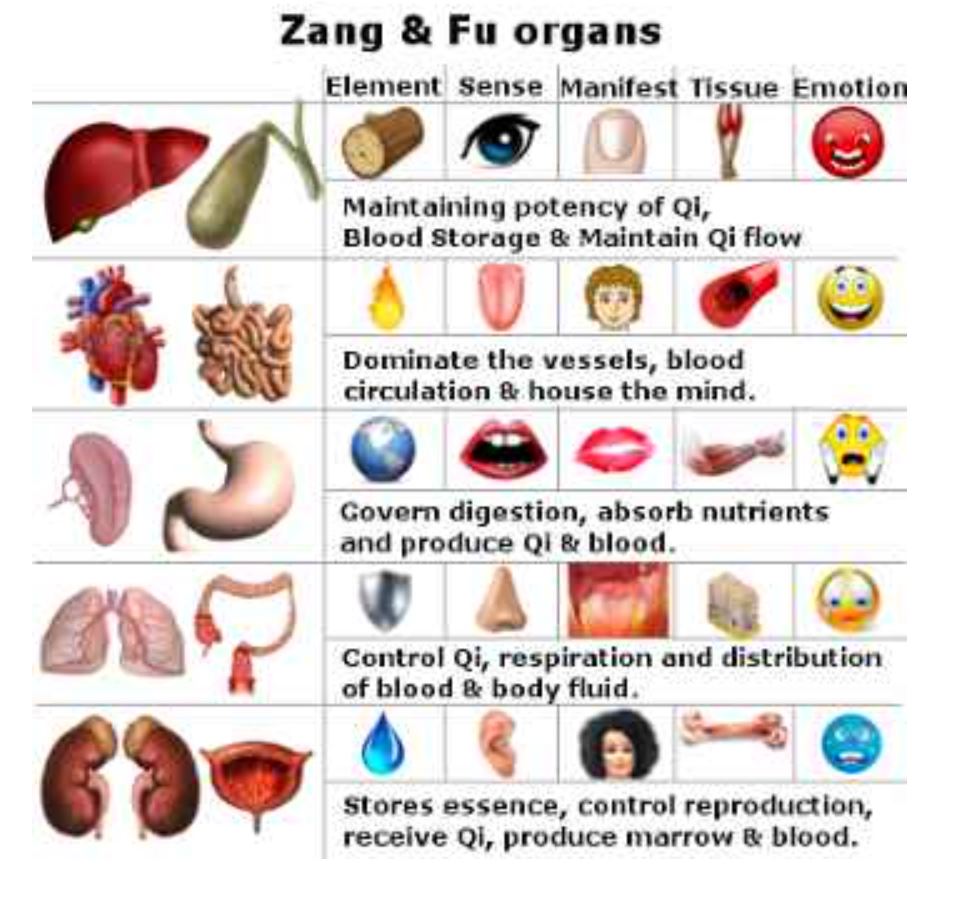 The functional entities are responsible for performing the five cardinal functions that maintain health within the body. The cardinal functions are:
The functional entities are responsible for performing the five cardinal functions that maintain health within the body. The cardinal functions are:
- Actuation-Locomotion of the Five Fundamental Substances.
- Warming-Regulation temperature
- Defense-Protection against foreign pathogens
- Containment-Prevention of excessive drainage of different jinye
- Transportation-Converting nutrition and breathing into qi, xue, and jinye
If there is a qi imbalance within the any of the functional entities, illness may occur.
Given the importance of qi in Oriental Medicine, it necessary to understand the TCM concept Zang-fu.
What is Zang-fu?
The Zang-fu is a collection organs that produce and regulate qi within the body. Unlike in western medicine, these organs should not be thought of as anatomical structures, but rather as interconnected functions that explain how qi is produced within the body. The functions performed by each organ are referred to as the organ’s qi (i.e. Heart qi). In total, there are 11 organs, five Zang and six fu.
Zang organs: Zang (脏) refers to the five organs that are yin. Collectively, their primary purpose is to produce and store qi, xue (blood), Jinye (body fluids), Jing (essence), and shen (Spirit). They are the:
- Heart: Responsible for storing shen. Physically, it governs blood and the meridians. Emotionally, it controls joy.
- Spleen: The Spleen is one of the most dynamic organs. It is responsible for the transportation of essential qi and xue (blood) from nutrition and water, and actuating them to the other Zang It also helps to contain xue within the meridians. Physically, it governs the limbs. Emotionally, it controls pondering.
- Lung: The primary function of the lung is the actuation of pectoral qi, which is produced by breathing. Physically, it governs the skin and hair. Emotionally, it controls grief.
- Kidney: The kidney is a dynamic organ. It is responsible for the containment of shi, which guides conception, development, birth, and growth. Physically, it is responsible for producing marrow.
- Liver: The primary function of the liver is to ensure that qi can flow freely through the meridians. It also stores blood and maintains the tendons.
 fu organs: fu (腑) refers to six organs that are yang. Collectively, their primary function is to transmit and digest nutrients without storing them and to excrete waste. They are:
fu organs: fu (腑) refers to six organs that are yang. Collectively, their primary function is to transmit and digest nutrients without storing them and to excrete waste. They are: -
-
- Stomach- The stomach is considered to be of primary importance in TCM. It is here that food and water are first digested and nutritional qi is extracted. After food is digested, it is sent to the small intestine, for further purification.
- Small Intestine- The small intestine connects with the stomach and its main function is to further purify the nutrition that was partially digested by the stomach from a turbid into a clear substance. After purification, it transports the clear substance throughout the body, while expelling the turbid.
- Large Intestine-It’s primary function is to receive waste material from the small intestine and to absorb any remaining good fluids while transforming the remaining waste into feces.
- Urinary Bladder- As the small intense purifies fluids, its sends turbid fluids to the urinary bladder, whose primary function is to store and discharge urine.
- Gall Bladder: The gall bladder is attached to the liver and its primary function is to transform any of the liver’s remaining qi into bile.
- Sanjiao: It should be noted that the Sanjiao does not have a Western anatomical equivalent. Roughly, it can be thought of as 3 placeholders/cavities or jiao for the organs within the body’s trunk. The 3 jiao are:
- Upper jiao: holds the heart and lung
- Middle jiao: holds the spleen and stomach,
- Lower jiao: holds the kidney and urinary bladder.
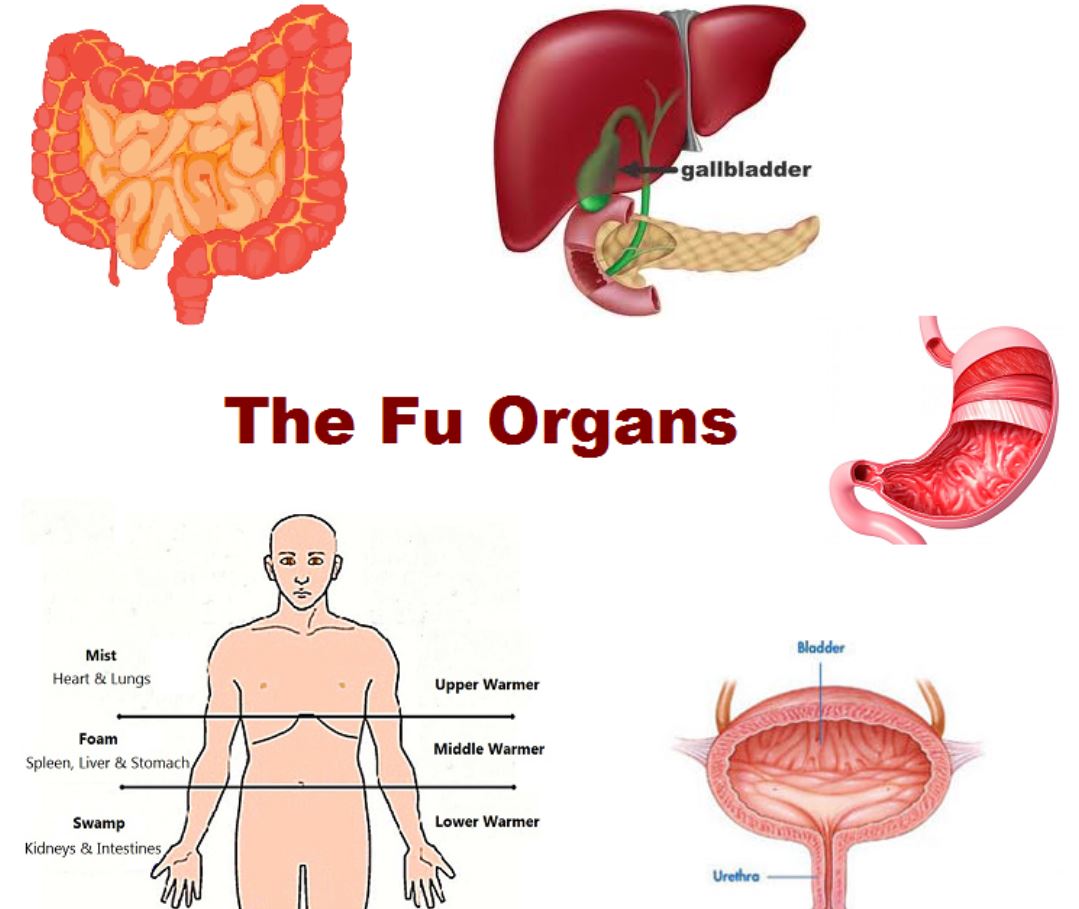 Zang-fu as a Wu Xing Cycle:As mentioned earlier, each of the Zang-fu organs has a yin-yang pair and follows a Wu Xing cycle. Wu Xing, which translates into the Five Phases or Five Elements, is the notion that the change of the cosmos occurs in a cyclical pattern of five stages.
Zang-fu as a Wu Xing Cycle:As mentioned earlier, each of the Zang-fu organs has a yin-yang pair and follows a Wu Xing cycle. Wu Xing, which translates into the Five Phases or Five Elements, is the notion that the change of the cosmos occurs in a cyclical pattern of five stages. 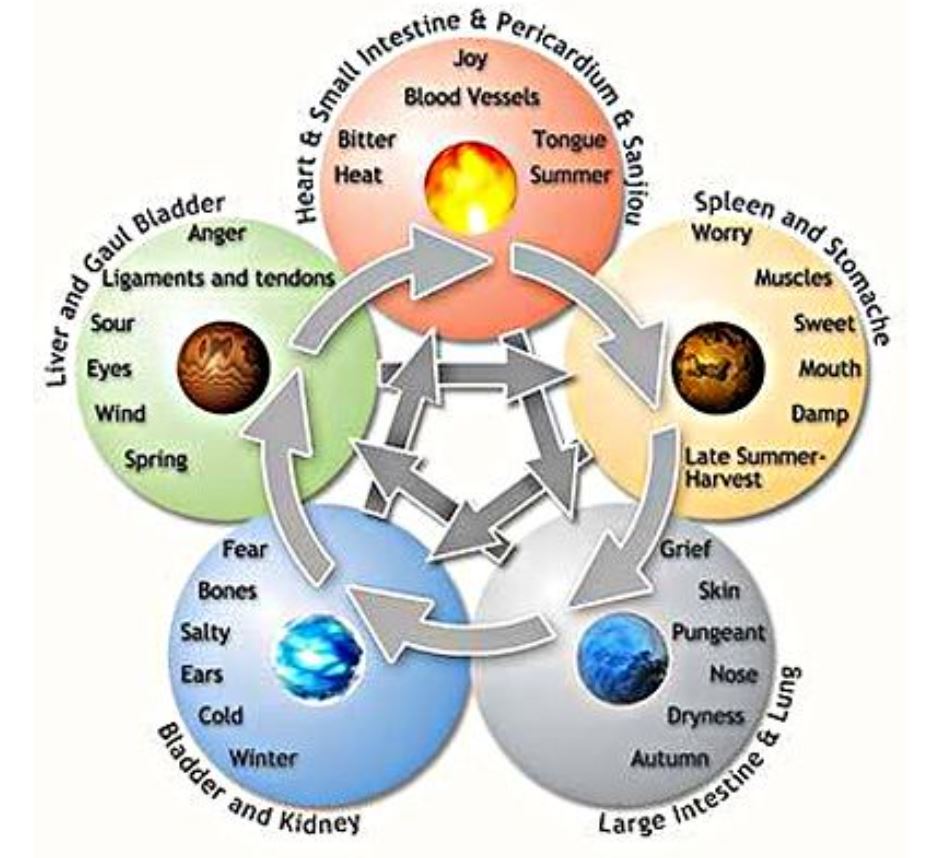 This means that each Zang-fu pair corresponds to one of the Five Elements and that they interact in a cyclical function with each other. The chart below helps demonstrate this relationship.
This means that each Zang-fu pair corresponds to one of the Five Elements and that they interact in a cyclical function with each other. The chart below helps demonstrate this relationship.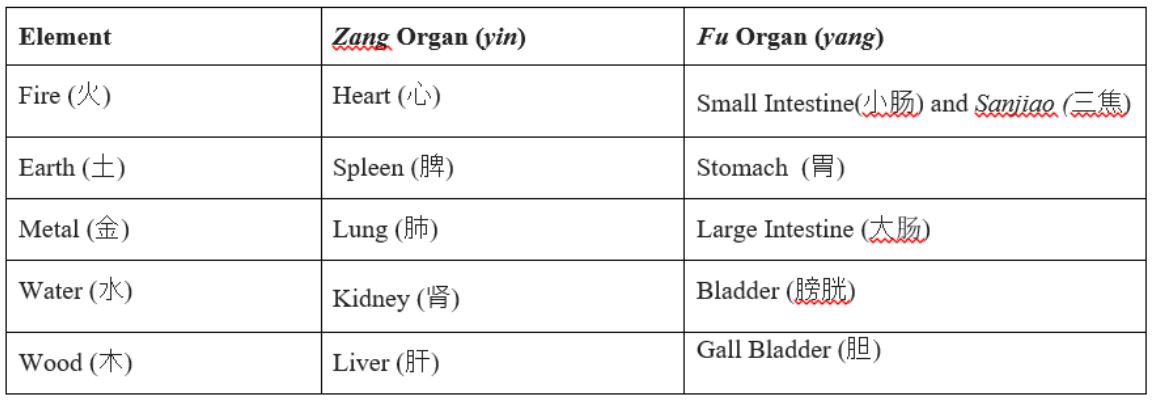 As mentioned previously, the Five Fundamental Substances are what make and sustain life. Given that the Zang-fu organs help produce and maintain the substances, their importance in Traditional Chinese Medicine cannot be understated.What has yet to be discussed is how the fundamental substances travel from the organs to the rest of the body. In the future, we will discuss the concept of the Jing-luo (meridian channels) and how they impact health.
As mentioned previously, the Five Fundamental Substances are what make and sustain life. Given that the Zang-fu organs help produce and maintain the substances, their importance in Traditional Chinese Medicine cannot be understated.What has yet to be discussed is how the fundamental substances travel from the organs to the rest of the body. In the future, we will discuss the concept of the Jing-luo (meridian channels) and how they impact health.
-
-------------------------------------------Other interesting relations with cosmos
有种说法,天空里的28星宿其实随时决定着我们人体五脏六腑的运动。
宇宙中的星宿就好像是给人类提供牛奶的奶牛,给予我们各种真气。
譬如东方七宿(簸、尾、心、房、氐、亢、角)在春天是旺相,而肝藏和东方七宿共同旺相,这是肝藏的大旺相。在这个过程中,东方七宿对肝藏的运动起决定性作用(肝在空间方位上收受东方木气)古人甚至发觉肝藏真气是绿色的,形态为青龙,这种绿色会随着时间和环境发生变化,有时深绿而近乎青色。有趣的是,这7个星宿也略有木气,好大喜奢却十分讲忠义。
譬如西方七宿(参、觜、毕、昴、胃、娄、奎)传达真气给肺藏,肺藏中的真气神形就是一只白虎的模样。
譬如北方七宿(壁、室、危、虚、女、牛、斗)传达真气给肾藏,肾藏中的真气会形成一个龟蛇的形象,很旺的时候也会体现为一只双头鹿。
譬如南方七宿(轸、翼、张、星、柳、鬼、井)传达真气给心藏,它们和地球上所有美丽生灵的心藏同步旺相,而心藏中的真气是心神,外形像一只朱雀。
------------------------------
何謂 任督二脈 ? 氣功明師 涂金盛老師點傳有緣人!

